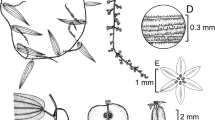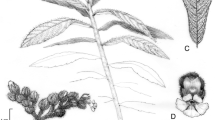Abstract
Desmaria mutabilis is unique inLoranthaceae in having dimorphic shoots, the short shoots producing a terminal inflorescence. Other unusual features in the family are well differentiated bud scales and deciduousness. The normal position of mature plants on the trunks of large trees is shown to be a consequence of profuse vegetative reproduction from the epicortical roots, the predominant growth direction of the latter towards the trunk from the original site of establishment on a lateral branch, and the ability of epicortical roots to generate haustorial contacts through heavy host bark. The seedling is heterocotylar, one cotyledon being phanerocotylar, the other cryptocotylar and functioning as a haustorial organ in the endosperm. It is suggested thatDesmaria is a member of the primitive complex of loranthaceous genera which includesGaiadendron.
Similar content being viewed by others
References
Barlow, B. A., 1983: Biogeography ofLoranthaceae andViscaceae. — InCalder, D. M., Bernhardt, P., (Eds.): The Biology of Mistletoes. — Sydney: Academic Press.
——, 1973: The classification of the generic segregates ofPhrygilanthus (=Notanthera) of theLoranthaceae. — Brittonia25, 26–39.
Engler, A., Krause, K., 1935:Loranthaceae. — InEngler, A., Prantl, K., (Eds.): Die Natürl. Pflanzenfam., 2. ed.,16b, 98–203.
Feuer, S., Kuijt, J., 1985: Fine structure of mistletoe pollen. VI. Small-flowered neotropicalLoranthaceae. — Ann. Miss. Bot. Gard. (in press).
Hamilton, S. G., Barlow, B. A., 1963: Studies in AustralianLoranthaceae. II. Attachment structures and their interrelationships. — Proc. Linn. Soc. n. s. Wales88, 74–90.
Hill, A. W., 1906: Morphology and seedling structure of the geophilous species ofPeperomia. — Ann. Bot.20, 395–427, pl. 19 – 30.
Kuijt, J., 1964: Critical observations on the parasitism of New World mistletoes. — Can. J. Bot.42, 1243–1278.
—— 1970: Seedling establishment inPsittacanthus (Loranthaceae). — Can. J. Bot.48, 705–711.
—— 1977: Haustoria of phanerogamic parasites. — Ann. Rev. Phytopathol.17, 91–118.
—— 1981: Inflorescence morphology ofLoranthaceae — an evolutionary synthesis. — Blumea27, 1–73.
—— 1982a: Epicortical roots and vegetative reproduction inLoranthaceae (s. s.) of the New World. — Beitr. Biol. Pflanzen56, 307–316.
—— 1982b: Seedling morphology and its systematic significance inLoranthaceae of the New World, with supplementary comments onEremolepidaceae. — Bot. Jahrb.103, 305–342.
——, 1982: A re-evaluation ofPhrygilanthus nudus Molina (Loranthaceae). — Brittonia34, 42–47.
Poeppig, E. F., Endlicher, S. L., 1838: Nova Genera ac Species Plantarum, ..., 2, 61, Pl. 183. — Leipzig: F. Hofmeister.
Smart, C., 1952: The life history ofTupeia Cham. etSchl. (Loranthaceae). — Trans. Roy. Soc. N. Z.79, 459–466.
Tainter, F. H., French, D. W., 1971 a: Identificación de los muérdagos (Lorantháceae) del Valle Central de Chile. — Turrialba21, 197–201.
—— 1971 b: Distribution of mistletoes in the Central Valley of Chile. — Turrialba21, 225–228.
Van Tieghem, P., 1895: Sur le groupement des espèces en gènres dans la tribu desGaiadendrées de la famille desLoranthacées. — Bull. Soc. Bot. France42, 455–460.
Vogel, E. F. de, 1979: Seedlings of Dicotyledons-structure, development. types. — Dissertation, University of Leiden.
Wiens, D., Toelken, H. R., 1979:Loranthaceae. — InLeistner, O. A., (Ed.): Flora of Southern Africa,10 (1), 1–41.
Author information
Authors and Affiliations
Rights and permissions
About this article
Cite this article
Kuijt, J. Morphology, biology, and systematic relationships ofDesmaria (Loranthaceae). Pl Syst Evol 151, 121–130 (1985). https://doi.org/10.1007/BF02418024
Received:
Issue Date:
DOI: https://doi.org/10.1007/BF02418024




